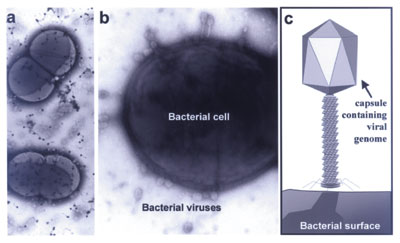| 2003 |

|
YEAR BOOK |
Cork Institute of Technology & *Teagasc, Moorepark
|
An alternative to antibiotics for eliminating
hospital superbugs
|

(a) suspension of bacteria and bacteriophage under electron microscope
(b) higher magnification showing bacteriophages attaching to bacterial cell surface
(c) schematic of a bacteriophage landing on a bacterial surface rather like a lunar landing module. After attachment, the bacteriophage injects its DNA genome into the bacterium leading ultimately to death of the bacterium.
In this context, the exploitation of bacteriophages (viruses which specifically kill bacteria) as antibacterial agents has received increasing attention in recent years. The approach has been widely adopted in the former Soviet Union as far back as the 1930s and companies there still supply bacteriophage cocktails as tablets or suspensions for treatment of infections in humans and animals.
We have collected and characterised a number of anti-staphylococcal bacteriophages, which effectively kill representatives of all the above-mentioned antibiotic resistant strains of S. aureus including isolates from Irish hospitals and isolates from bovine infections. On the basis of genomic and electron microscopic analysis, these bacteriophages fall into the myoviridae family. Their mode of action is (a) specific receptor-mediated attachment of the bacteriophage to the bacterial cell surface (b) injection of the bacteriophage genome into the bacterial cytoplasm (c) hijacking of the bacterial DNA replication machinery to replicate the bacteriophage genome (d) synthesis of bacteriophage structural proteins (e) assembly of 50-200 progeny bacteriophages within the bacterial cytoplasm (f) bacteriophage-directed bursting of the bacterial cell and release of progeny bacteriophages (g) repetition of this cycle on other bacteria in the environment. The cycle in S. aureus takes about 35 minutes.
To date, bacterial challenge experiments using these bacteriophages have been confined to in-vitro situations. Nevertheless, we have demonstrated that high titre (108/ml) preparations of bacteriophages have negligible immunogenicity in animals. In addition, anti-staphylococcal bacteriophages have no effect on other bacterial genera, nor do they have any effect on eukaryotic cells. Currently we are evaluating the host spectrum of selected polyvalent bacteriophages and are continuously incorporating a wider range of antibiotic resistant strains from different Irish hospitals into the study.
Contact: Dr Aidan Coffey, Department of Biological Sciences, Cork Institute of Technology, Cork; Tel: +353-21-4326306; E-mail: [email protected]